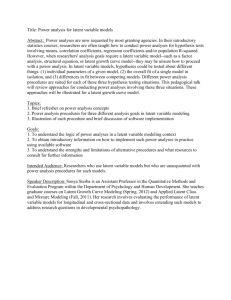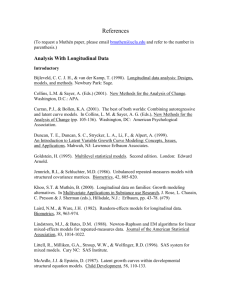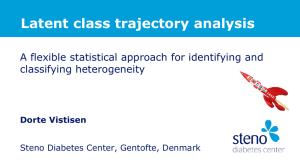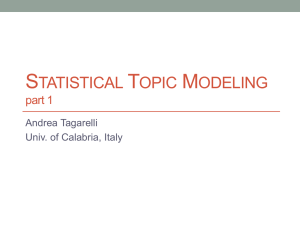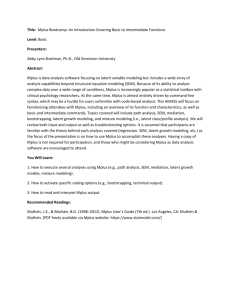Latent variable modelling of longitudinal data: applications of Mplus
advertisement
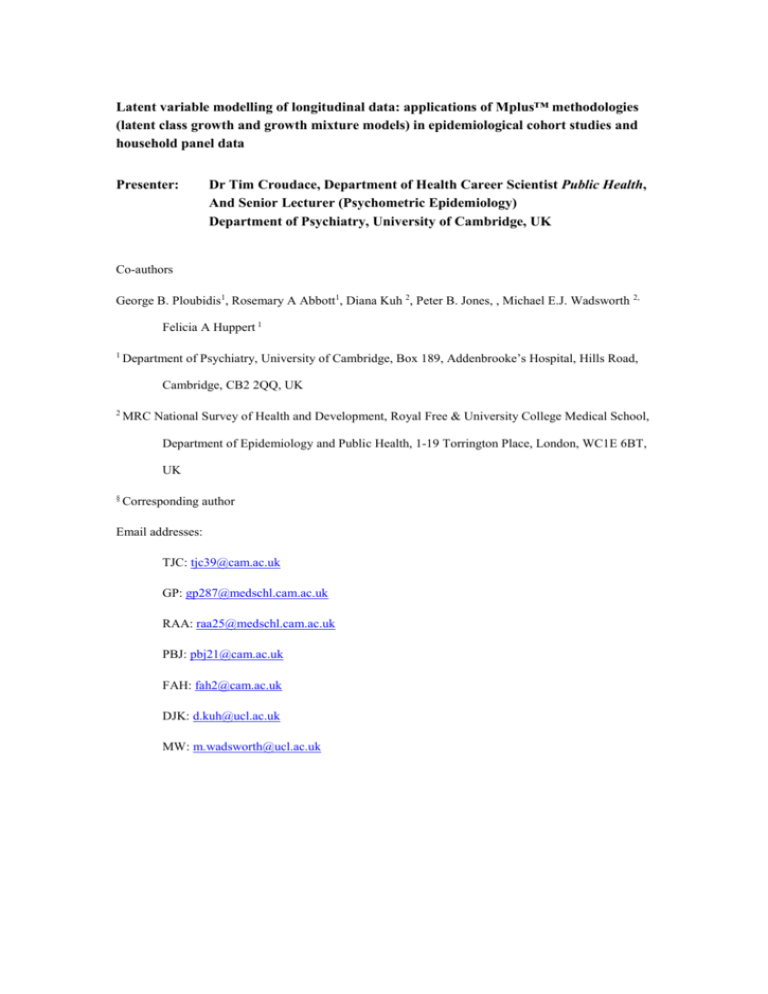
Latent variable modelling of longitudinal data: applications of Mplus™ methodologies (latent class growth and growth mixture models) in epidemiological cohort studies and household panel data Presenter: Dr Tim Croudace, Department of Health Career Scientist Public Health, And Senior Lecturer (Psychometric Epidemiology) Department of Psychiatry, University of Cambridge, UK Co-authors George B. Ploubidis1, Rosemary A Abbott1, Diana Kuh 2, Peter B. Jones, , Michael E.J. Wadsworth 2, Felicia A Huppert 1 1 Department of Psychiatry, University of Cambridge, Box 189, Addenbrooke’s Hospital, Hills Road, Cambridge, CB2 2QQ, UK 2 MRC National Survey of Health and Development, Royal Free & University College Medical School, Department of Epidemiology and Public Health, 1-19 Torrington Place, London, WC1E 6BT, UK § Corresponding author Email addresses: TJC: tjc39@cam.ac.uk GP: gp287@medschl.cam.ac.uk RAA: raa25@medschl.cam.ac.uk PBJ: pbj21@cam.ac.uk FAH: fah2@cam.ac.uk DJK: d.kuh@ucl.ac.uk MW: m.wadsworth@ucl.ac.uk Abstract Latent variable frameworks offer a flexible range of analytical models for longitudinal data (Muthén 1991, 2001, 2004). Analysis potential for applied researchers has been greatly extended by commercial software developments e.g. Mplus 3.1 (Muthén and Muthén, 19982004; www.statmodel.com) and gllamm procedures (Rabe-Hesketh, Pickles and Skrondal, 2001; www.gllamm.org) implemented in Stata. Here, modelling extensions and new estimation procedures allow for a comprehensive integration of latent variable models with random effects, latent classes and structural equations. Modelling can therefore combine latent class approaches to population heterogeneity modelling with random effects (linear mixed) modelling of individual’s trajectories. Latent variable approaches to construct scaling (psychometric models) can also be incorporated to correct for measurement error. Missing data can be incorporated. Our interest is in a life-course developmental approach to the study of psychopathology and behaviour (Willet et al, 1998; Kuh and Hardy, 2002). Our talk/chapter will demonstrate four types of analysis: 1) latent class analysis of binary repeated measures; 2) latent growth modelling; 3) growth mixture modelling, and 4) parallel process modelling of two latent, inter-dependent growth processes. We will illustrate the types of model that can be estimated using high quality epidemiological cohort studies (Croudace et al, 2002) including birth cohort studies and household panel data. Our first example concerns latent class analysis of binary repeated measures (Croudace et al, 2002). Here the outcome of interest is night-time bed-wetting (present or absent) recorded on six occasions (ages 4,6,8,9,11 and 15 years) on children in the Medical Research Council 1946 National Survey of Health and Development birth cohort study (Wadsworth, 1991; Wadsworth and Kuk, 1997; Wadsworth et al, 2003). Enuresis as an antecedent of adult health outcomes will be explored. Other models from the latent variable framework will be exemplified using repeated measures from the 12-item GHQ (General Health Questionnaire; Goldberg, 1972) recorded by participants in the BHPS (British Household Panel Survey; Taylor (2004) http://www.iser.essex.ac.uk/ulsc/bhps). Bivariate outcome modelling will concern trajectories for positive and negatively worded items. Extensions of these modelling frameworks will be discussed, and Mplus scripts (input and output) will be mounted on a website prior to the conference so that participants can use these pedagogical examples to develop their own modelling skills and ideas. References Croudace, T.J., Jarvelin, M.R., Wadsworth, M.E. & Jones, P.B. (2003). Developmental typology of trajectories to nighttime bladder control: Epidemiologic application of longitudinal latent class analysis. American Journal of Epidemiology, May 1;157(9):834-42. Goldberg, D.P (1978) General Health Questionniare 12 item version. NFER Nelson : Windsor, Berkshire Kuh, D and Hardy, R. (2002) A life-course approach to women’s health. Oxford University Press : Oxford. Muthén, B.O (1991). Analysis of longitudinal data using latent variable models with varying parameters. In L. M. Collins & J. L. Horn (Eds.), Best methods for the analysis of change: Recent advances, unanswered questions, future directions (pp. 1–17). Washington, DC: American Psychological Association. Muthén, B.O (2001). Second-generation structural equation modeling with a combination of categorical and continuous latent variables: new opportunities for latent class-latent growth modeling. In L. M. Collins & A. Sayer (Eds.), New methods for the analysis of change (pp. 289–322). Washington, DC: American Psychological Association. Muthén, L. & Muthén, B.O (1998-2004) Mplus: The comprehensive modeling program for applied researchers - Users guide. Los Angeles, CA. Muthén, B. (2004). Latent variable analysis: Growth mixture modeling and related techniques for longitudinal data. In D. Kaplan (ed.), Handbook of quantitative methodology for the social sciences (pp. 345-368). Newbury Park, CA: Sage Publications. Rabe-Hesketh, S. , Pickles, A. and Skronsal, A. (2001) GLLAMM technical report 2001/01. Department of Biostatistics and Computing, Institute of Psychiatry, King’s College, University of London : London. Skrondal, A. & Rabe-Hesketh, S. (2004) Generalized latent variable modeling: multilevel, longitudinal and structural equation models. Chapman and Hall/CRC : London. Taylor, Marcia Freed (ed). with John Brice, Nick Buck and Elaine Prentice-Lane (2004) British Household Panel Survey User Manual Volume A: Introduction, Technical Report and Appendices. Colchester: University of Essex Wadsworth, M.E.J. (1991) The imprint of time. Oxford University Press : Oxford. Wadsworth MEJ, Mann SL, Rodgers B, Kuh, D., Hilder, W. and Yusef, E.F. (1992). Loss and representativeness in a 43 year follow-up of a national birth cohort. Journal of Epidemiology and Community Health, 47, 300–4. Wadsworth ME, Butterworth SL, Hardy RJ, Kuh DJ, Richards M, Langenberg C, Hilder WS & Connor M. (2003) The life course prospective design: an example of benefits and problems associated with study longevity. Social Science and Medicine, 57, 2193-205. Willett, J. B., Singer, J., & Martin, N. C. (1998). The design and analysis of longitudinal studies of development and psychopathology in context: Statistical models and methodological recommendations. Development and Psychopathology, 10,395–426.


